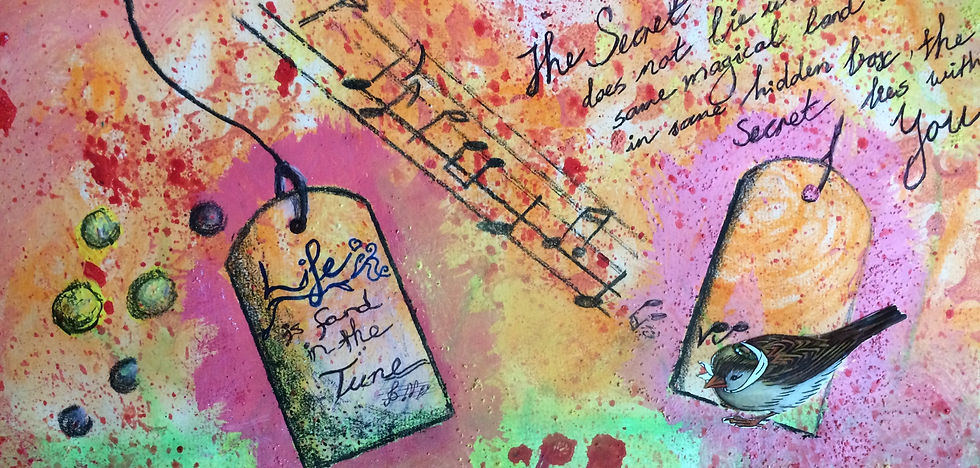Expressive Arts for children & adolescents: a tool for emotional expression and personal development
- R.Gillmann
- Dec 19, 2019
- 6 min read
Art making as a form of exploration, a mode of communication and a tool for personal expression assists children in their emotional and psychological development.
The importance of nurturing childhood and adolescent mental health is slowly but gradually coming to the fore. However, the emphasis of mental health still seems to be directed more towards the adult, with little mention of nurturing, supporting and strengthening youngsters' emotional and psychological well-being, fostering their emotional resilience and how adolescents themselves can build upon their personal resources for mental health.
We are quick to cry-out when we see or hear about child abuse and neglect, and somehow this underlying myth exists that as soon as the traumatised child, the abused or neglected child, the emotionally hurt child, is placed outside their distressing contexts, or as soon as the child with learning disabilities, behavioural difficulties, or cognitive problems receives adequate attention, that their problems will be solved, their world fixed within a few weeks, and their emotional well-being will be highly functioning as soon as the child recognises how lucky they are to receive help. However, emotional well-being, psychological health or mental-health is complex and takes time to restore. Emotional wounds are difficult to heal and build-up, and for the young person to feel emotionally stable and psychologically balanced again, even after months or years of emotional set-backs,…if at all.
Children and adolescents need a safe and supportive home, school and after-school environment to strive. However, these factors are not always possible to attain, nor is it always possible to really know what exactly is going on in each child's home and familial environment. Therefore, the school and after-school care are an important environment where supportive interventions can make a difference to the young persons well being and mental health. Mentally healthy children, youngsters with resilience skills, and emotionally balanced adolescents, are by nature more productive in their school-work, are better in focusing and concentrating, feel better about themselves and show healthy self-confidence, expressing drive and increased school performance than children and adolescents who are internally struggling.
There are numerous factors that can affect emotional well-being and psychological coping amongst children and adolescents. Often, childhood depression, fear or anxiety, behavioural outbreaks, or mood disturbances are personal responses indicating that something out of the ordinary is happening in the youngster’s life.
Only a minority of children with emotional and behavioural disorders in school, actually have access to, or seek therapeutic services or psychological help. As it seems, many schools in Namibia are not adequately equipped to offer basic psychological services or counselling to students, which make it an increasing concern of how children and adolescents who have psychological disorders are supported. Additionally it calls for question how these children learn to cope and manage throughout their teenage years up to adulthood and how their adult years will be influenced in the long-term.
At times children’s mental, psychological, cognitive or emotional development takes a knock. Children and adolescents who suffer from physical-, emotional-, psychological-, cognitive-, perceptual-, and learning difficulties are often struggling from low self-esteem and declining self-confidence; just as much as unfortunate life circumstances, stressors, unrealistic expectations, distressing interrelationships, and increasing demands, strain the ability to cope with life effectively. Furthermore, experiencing trauma or witnessing a traumatic event can have serious and long-term psychological impact on the individual and can be experienced in various scenarios, such as:
being involved in a car accident, being victim of a crime or witnessing crime, sexual or physical abuse, rape or assault, being a victim of bullying, diagnosis of a chronic illness, experiencing parental separation or divorce, living with a caregiver or parent suffering from a mental illness, or substance-abuse disorder experiencing family violence, loss of a loved one, any other event where the person is confronted with death or with a severe disruption in life.
Often, children and adolescents who are emotionally struggling show changes in behaviours and moods, decreased learning ability, difficulties with concentration, avoidance or a lack of participation in class, not carrying-out class work, decreased learning ability, sudden development of fear and anxiety, unusual emotional fluctuations, sudden bouts of aggression or acting-out, obsessive behaviours, self-harm, eating disorders, or childhood/ adolescent depression. Without adequate support structures, opportunities for personal expression or methods of making sense of the world, the youngster's emotional well-being, as well as their cognitive abilities are strained. To mitigate long-term psychological and emotional effects it is important for the child/ adolescent to regain personal equilibrium, to build resilience and strengthen their inner resources.
When the mind encounters something it cannot make sense of, it causes distress, internal unease, and confusion. Especially children and adolescents are too ashamed to talk about their experiences in the fear of being singled out, of being ridiculed, and of being pushed away by their peers, due to their often uncomfortable and burdensome personal accounts. Sometimes experiences and feelings cannot be fully expressed in words and involvement with imagery facilitates meaning making. It is known that creative expression and non-evaluative art making positively influences cognitive, emotional, and psychological well-being.
Art and creativity has been found to be an important outlet for children and adolescents. Art making opens a channel for non-verbal expression and allows this confusion to be expressed, acknowledging one’s feelings, and providing the opportunity to release the unease.
Through art the invisible becomes more tangible and enables a process of transformation which manifests in the everyday life. Expressive arts therapy is used as a tool for exploring, recognising, and expressing emotions. It enables externalisation of the problem story and to articulate the problem, acting as a tool to communicate unconscious aspects that can reach a state to work and deal with in a more effective manner. Through this, it creates distance to the situation and allows a change of perspective, assisting in gaining clarity and insight, and building solutions to the problematic situation.
We all have the right for our emotions to find expression and to embrace the beauty of our inner selves.
Creative expression and engagement in the arts have shown to improve children’s verbal and creative thinking, problem-solving skills, strengthening their self-awareness and self-confidence, their self-perceptions of mastery, emotional regulation, and intrinsic motivation.
The art in art therapy acts as a means of communication, providing a channel for emotional expression, a method to work through emotions, feelings, underlying fears, and emotional blockages. Through this, the art-making fosters feelings of mastery and achievement, creative accomplishments, and losing oneself in a world of possibilities without rigidity, it inspires creative problem-solving, self-awareness and regaining inner personal structure, management of emotional regulation, and insight of one’s capabilities. The haptic and active creative interaction with the art materials activates multi-sensory stimulation and involves complex interactions of both brain hemispheres applying a myriad of brain processes.
Art therapy provides an opportunity for personal and authentic self-expression, functioning as a therapeutic and safe means for emotional engagement, and utilised as a personal growth tool. Artworks become an outlet for emotions, for untold stories, for developing ideas, for new insights and inner workings. The creative process assists in making sense of the world, developing self-awareness, and formation of identity.
The aims of creative expression within the arts therapies are to:
address emotional, cognitive and psychosocial needs, offer a sense of control and coping through difficult life transitions and events, reduce stress, anxiety, and improve moods, as therapeutic art making is relaxing and promotes a sense of well-being, encourage a positive outlet for emotions of stressful and often fear-induced situations, encourage and inspire communication, develop and support self-expression, foster self-efficacy and autonomy through learning creative skills, foster a sense of pride, confidence, accomplishment, self-esteem and self-worth, develop and strengthen self-reflection, strengthen creative thinking, divergent thinking and problem solving skills, calm the mind, body and soul.
Often individuals, especially children and adolescents, suffer emotional burdens and internal stress in silence. It is thus important to ask the following questions: how emotionally balanced are children and teenagers at home and at school? How many youngsters suffer from a psychological disorder? And how do we know? Can we as teachers, caregivers, parents, and responsible adults recognise a child suffering in silence, with childhood depression, with social anxiety, a child who is a victim of bullying or has experienced a traumatic event, or a child who is silently grappling with low self-confidence and feelings of unworthiness or shame? And what can we do to help in offering avenues and opportunities for them to gain self-understanding and insight, empower them with knowledge of how to cope more effectively, and how to strengthen their resilience?
References:
American Art Therapy Association (AATA). (2018) An Expert on School-Based Art Therapy Explains how Art Therapy Helps Children Make Sense of the Insensible. Retrieved from https://arttherapy.org/art-therapy-helps-children-make-sense-of-the-insensible/
Cortina, M.A. & Fazel, M. (2015) The Art Room: An evaluation of a targeted school-based group intervention for students with emotional and behavioural difficulties, in The Arts in Psychotherapy 42 (2015) 35–40
McDonald, A., & StJ Drey, N. (2018) Primary-school-based art therapy: a review of controlled studies, in International Journal of Art Therapy, 23:1, 33-44, DOI: 10.1080/17454832.2017.1338741
Malchiodi, C. (ed.) (2013) Art Therapy and Health Care. The Guilford Press: New York
NYU Steinhardt. (2018) Art Therapy in Schools Program Exhibition Showcases the Work of
New York City’s At-Risk Children. Retrieved from https://steinhardt.nyu.edu/site/ataglance/2013/11/art-therapy-in-schools-program-exhibition-showcases-the-work-of-new-york-citys-at-risk-children.html














Commentaires